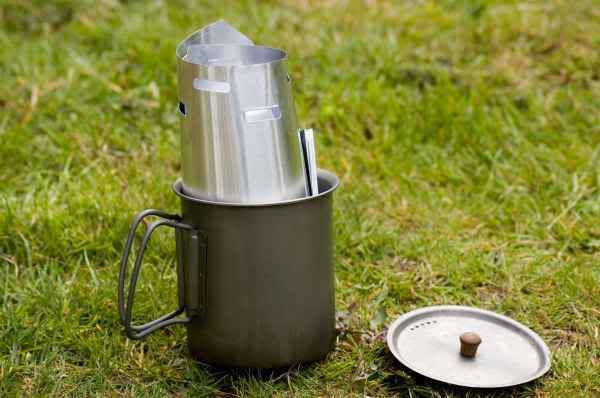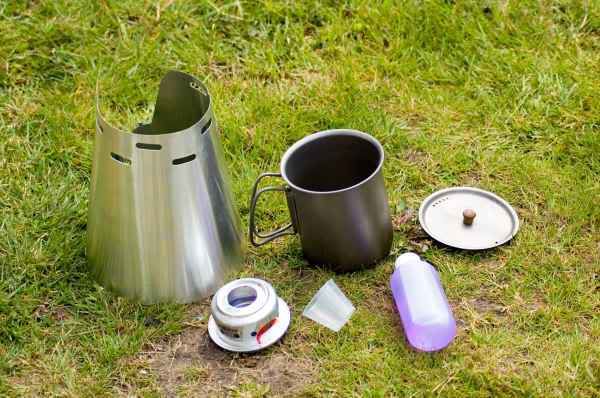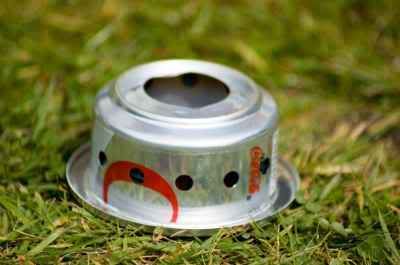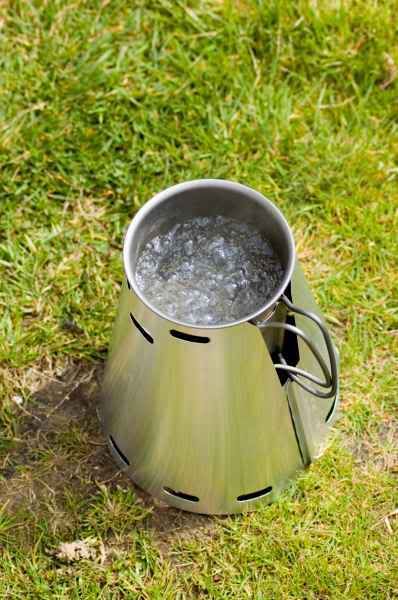I've been playing around making a few different pepsi can stoves lately as I'm trying to get my pack weight down and I do like cooking with meths.
I saw this stove after another bought of coursework marking avoidance and loved the simplicity of the idea... so I bought one
The stoves are made specific for each type of cup by a company in the US called Trail Designs when I first looked on their site they had the stoves for Snow Peak, Vargo and Backpackinglight. Not seeing the Alpkit Mytimug I sent them an email, and had a reply from Rand within a few hours saying that it was the same as the Vargo Ti Lite and that I could in the UK from Winwoods - excellent service, and they've since added the Alpkit mug to their website.
The caldera is getting some excellent reviews from lightweight backpackers and I was gagging for this to arrive so that I could play...
I ordered the stove from Winwood Outdoors on Thursday and it arrived Friday morning (again top notch service). First impressions were good, the cone was bigger than I was expecting but when you look at the size of Alpkits Mytimug it needs to be. The stove is a pepsi can and the workmanship is top notch.
The system is incredibly light, without the cup it weighs in at 57g and that includes the windshield, the burner, 160ml fuel bottle and measuring cup (supplied). With the mug (127g with lid) this weighs in at 184g. I filled the bottle and my total cook system weighed 300g.


The Burner
Now the stoves that I've been playing around with have either been the pressure style stoves or trangia mock ups with the jets, usually side burners. This one was neither of those.

The caldera stove is more about efficiency than maximum burn time, working on the theory that its more important to keep weight down than it is to shave off the extra time required to boil the water. The burner consists of ventillation holes around the outside of the burner, then an inner jacket, with holes near the top. The outer holes line up with those in the windshield so the air blows in and mixes with the burning meths at the top of the stove giving a very efficient and more complete burn (no soot at all on the bottom of the cup). The stove does have a shallow dish attached as a pre-heat for very cold conditions but I didn't find this necessary.
The Cone
The cone is thin and initially I wondered if this would prove slightly flimsy, but the shape once slotted together is very strong. The join is by way of a dove tail slot, first time this took a bit of sliding in until I flicked through the leaflet and realised there was a angle cut into one piece to aid this... much easier...
In Use
I want to start comparing some different meths stoves so I decided instead of filling the cup up (700ml) I'd go with 500ml as not all titanium cups are this big and it would allow better comparisons.
So 500 ml of water in the cup and 20ml of meths in stove using the measuring cup.
The stoves lights easily and I suppose the only draw back is that because its so efficient the flame is completely colourless (even less of a flicker than you normally get with meths).
Once lit the cone goes over the the top and cup sits in the cone, the lip of the cup rests snugly on the lip of the cone.

Because the cup sits inside the cone, the centre of gravity if very low, this is probably the most stable of systems I've used, it would actually take quite an effort to know this over... not that I tried..
Performance wasn't speedy by any means and took 9 minutes to bring 500ml of water to the boil. Total burn time was just over 11 minutes on 20 ml of meths. Now titanium is a very poor conductor so I'd be interested to test this on a mug made of another metal. What I am impressed with though is so little fuel manages to successfully boil this amount of water:

Summary
Initial impression is very good, this is a very efficient system, the shape of cone ensures that the majority of the heat is directed at the cup, whether the bottom or the sides, and the design of the burner and windshields means you get the as many BTUs from the meths as possible.
No means of simmering but then I'm going to use this with a insulated pot cosy, so as soon as the water is boiling I can add my food, and into the cosy.
Weight wise, 300g would give me easily about 8 cups, enough to boil 4 litres of water, this would be plenty for a weekend, even with the amount of coffee I normally consume. For longer times more fuel would be needed, but it is easy to calculate exactly how much, add a bit on for emergencies and still keep the weight to a minimum.
Looking fowrard to using this outside of the garden, away next weekend so I should get chance to give it a good testing then. I'll post some more pictures when I've had a chance to really put it through its paces. I might also try it with one of my pressure style stoves to see how they perform.
Matt
I saw this stove after another bought of coursework marking avoidance and loved the simplicity of the idea... so I bought one
The stoves are made specific for each type of cup by a company in the US called Trail Designs when I first looked on their site they had the stoves for Snow Peak, Vargo and Backpackinglight. Not seeing the Alpkit Mytimug I sent them an email, and had a reply from Rand within a few hours saying that it was the same as the Vargo Ti Lite and that I could in the UK from Winwoods - excellent service, and they've since added the Alpkit mug to their website.
The caldera is getting some excellent reviews from lightweight backpackers and I was gagging for this to arrive so that I could play...
I ordered the stove from Winwood Outdoors on Thursday and it arrived Friday morning (again top notch service). First impressions were good, the cone was bigger than I was expecting but when you look at the size of Alpkits Mytimug it needs to be. The stove is a pepsi can and the workmanship is top notch.
The system is incredibly light, without the cup it weighs in at 57g and that includes the windshield, the burner, 160ml fuel bottle and measuring cup (supplied). With the mug (127g with lid) this weighs in at 184g. I filled the bottle and my total cook system weighed 300g.


The Burner
Now the stoves that I've been playing around with have either been the pressure style stoves or trangia mock ups with the jets, usually side burners. This one was neither of those.

The caldera stove is more about efficiency than maximum burn time, working on the theory that its more important to keep weight down than it is to shave off the extra time required to boil the water. The burner consists of ventillation holes around the outside of the burner, then an inner jacket, with holes near the top. The outer holes line up with those in the windshield so the air blows in and mixes with the burning meths at the top of the stove giving a very efficient and more complete burn (no soot at all on the bottom of the cup). The stove does have a shallow dish attached as a pre-heat for very cold conditions but I didn't find this necessary.
The Cone
The cone is thin and initially I wondered if this would prove slightly flimsy, but the shape once slotted together is very strong. The join is by way of a dove tail slot, first time this took a bit of sliding in until I flicked through the leaflet and realised there was a angle cut into one piece to aid this... much easier...
In Use
I want to start comparing some different meths stoves so I decided instead of filling the cup up (700ml) I'd go with 500ml as not all titanium cups are this big and it would allow better comparisons.
So 500 ml of water in the cup and 20ml of meths in stove using the measuring cup.
The stoves lights easily and I suppose the only draw back is that because its so efficient the flame is completely colourless (even less of a flicker than you normally get with meths).
Once lit the cone goes over the the top and cup sits in the cone, the lip of the cup rests snugly on the lip of the cone.

Because the cup sits inside the cone, the centre of gravity if very low, this is probably the most stable of systems I've used, it would actually take quite an effort to know this over... not that I tried..
Performance wasn't speedy by any means and took 9 minutes to bring 500ml of water to the boil. Total burn time was just over 11 minutes on 20 ml of meths. Now titanium is a very poor conductor so I'd be interested to test this on a mug made of another metal. What I am impressed with though is so little fuel manages to successfully boil this amount of water:

Summary
Initial impression is very good, this is a very efficient system, the shape of cone ensures that the majority of the heat is directed at the cup, whether the bottom or the sides, and the design of the burner and windshields means you get the as many BTUs from the meths as possible.
No means of simmering but then I'm going to use this with a insulated pot cosy, so as soon as the water is boiling I can add my food, and into the cosy.
Weight wise, 300g would give me easily about 8 cups, enough to boil 4 litres of water, this would be plenty for a weekend, even with the amount of coffee I normally consume. For longer times more fuel would be needed, but it is easy to calculate exactly how much, add a bit on for emergencies and still keep the weight to a minimum.
Looking fowrard to using this outside of the garden, away next weekend so I should get chance to give it a good testing then. I'll post some more pictures when I've had a chance to really put it through its paces. I might also try it with one of my pressure style stoves to see how they perform.
Matt
